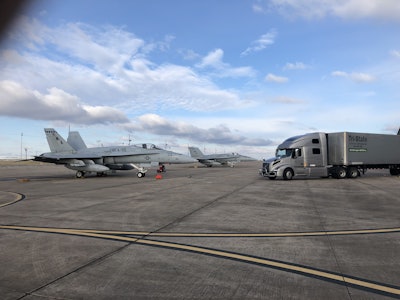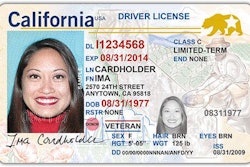 When Josh and Krystal Jesse moved into AA&E freight, their pay nearly doubled. They now own a 2019 Volvo VNL 860, occasionally hauling dry van but mostly flatbed for Tri-State Motor Transit.
When Josh and Krystal Jesse moved into AA&E freight, their pay nearly doubled. They now own a 2019 Volvo VNL 860, occasionally hauling dry van but mostly flatbed for Tri-State Motor Transit.Are you an experienced owner-operator with a clean driving record, looking for some way to specialize and make the big bucks?
One route is to make the leap to hauling arms, ammunition and explosives for the U.S. Department of Defense. And quite a leap it is to qualify for AA&E: You’ve got to be comfortable with running team, constantly being tracked, following unfamiliar regulations and investing in added permits and credentials.
Even if those aspects aren’t deal-breakers, it’s difficult to qualify as an owner-operator or a carrier. DOD opens the application process to approve carriers for AA&E freight only every few years, says Fred Rice, director of public and congressional affairs for DOD’s Surface Deployment and Distribution Command.
About 800 trucking companies are approved DOD service providers, but fewer than 20 of those can haul AA&E. Of those, only about five to eight haul the bulk of the freight, says John Wilbur, chief executive officer for the Daseke-owned Roadmaster Group, which includes Tri-State Motor Transit, the nation’s largest and longest-tenured AA&E carrier.
“As a carrier, you have to have a track record of hauling FAK [military freight all kinds] for a couple of years before qualifying,” Wilbur says. Besides checking a carrier’s safety record, DOD does background checks for management and ownership.
DOD also reviews a company’s financials to ensure the business is run well, says Rhonda Brown, operations manager for AA&E hauler PTS Worldwide. Also examined are “on-time pickup-and-delivery rate, your efficiency and how reliable you are.”
DOD’s carrier criteria are somewhat stacked against an independent with only a few trucks, so interested owner-operator teams usually lease to an approved AA&E fleet. They still have to go through a tedious process of obtaining the correct credentials and must meet other criteria.
That includes having a clean driving record, passing a background check and having newer equipment. Wilbur says each driver on a team has to have hazmat and tanker endorsements, along with a Transportation Worker Identification Credential (TWIC) card, which is required to enter most military bases and DOD facilities. Drivers also have to “maintain a government security clearance the entire time they’re operating in the AA&E sector,” Wilbur adds.
Other qualifications vary among companies. Wilbur says Tri-State generally requires two years driving experience with a perfect safety record. Brown says PTS looks back five years at drivers’ records.
“It’s a little lengthy of a process to get in to drive for us,” Brown says. “This is our only niche. We have to find the top 10% of drivers.”
[Related: How to get access to sometimes lucrative military freight]
Life on the road with AA&E freight
If you’re an owner-operator who’s always chafed at being subject to location tracking, you won’t like the intense oversight of AA&E work, not to mention the extreme caution required in matters other drivers never think about.
 Dale Malm and Donna Wheeler have been hauling AA&E at Tri-State for about six years. Donna has been trucking for 29 years, while Dale transitioned from the business sector shortly before he joined Donna at Tri-State.
Dale Malm and Donna Wheeler have been hauling AA&E at Tri-State for about six years. Donna has been trucking for 29 years, while Dale transitioned from the business sector shortly before he joined Donna at Tri-State.All movements are followed by DOD through a Qualcomm system in the truck, along with devices on all trailers. Van trailers also are equipped with door sensors so the government knows when a door is opened. Rice says DOD also requires a dashboard panic button and remote panic buttons for each driver in case something goes wrong while drivers are under an AA&E load.
Homosassa, Florida-based Dale Malm and Donna Wheeler, a husband-wife Tri-State team who have been hauling AA&E for about six years, say one of them has to be awake and guarding the truck at all times when under an AA&E load. If one of them is asleep in their 2019 Volvo VNL 860 and the driver needs to stop and get out for any reason, they have to wake their partner to watch the truck.
“Every time we stop, we have to inform [DOD] when we stop, where we stop and why,” Malm says. “Then when we leave, we have to tell them we’re leaving. They know exactly where we are, but we still have to communicate.”
 Josh and Krystal Jesse have been with Tri-State for about two years.
Josh and Krystal Jesse have been with Tri-State for about two years.Charleston, South Carolina-based Josh and Krystal Jesse, also a Tri-State owner-operator team, say AA&E haulers also have to avoid most bridges and tunnels and have to go around bigger cities.
“We can’t park within 300 feet of a building, and we have to call ahead to truck stops, because some may not want us there,” Josh says. “We have a list of which ones say ‘no’ and which ones want us to just fuel and go.”
He says if they are parked and guarding a load during their 30-minute break – logged on-duty, not driving rather than off-duty by special dispensation from FMCSA for such haulers – they are required to move their truck if another hazmat hauler parks next to them.
Drivers’ involvement in the loading and unloading usually is limited, if not completely no-touch. Malm and Wheeler, who haul mostly van AA&E freight, say they rarely see anything other than no-touch freight.
“We’re really impressed with the military bases we go on,” Malm says. “Not being in the military ourselves, we couldn’t ask for nicer or more helpful people. They do a really great job of strapping the items in or nailing boards to the floor to secure the load. Sometimes there’s difficulty getting it out with how well they secure it.”
The Jesses, on the other hand, mostly pull flatbed AA&E. Josh says they usually are responsible for any strapping, chaining or tarping after the loads are on the trailer.
“We do everything except drive the forklift,” Josh says. “They’ll do the blocking and bracing, nail boards down, but we do all the chaining, strapping and tarping. We’ve even gotten a couple van loads where we had to unload every box into a bunker.”
[Related: Young fleet PTS Worldwide clears hurdles for military freight]
Is the juice worth the squeeze when it comes to pay?
Getting the permits and credentials for AA&E requires not just the tedium of completing applications but also some costs. Josh Jesse already had his government security clearance after a decade in the Army, but Krystal had to obtain hers before she was able to haul high-security freight. The Jesses also had to get their hazmat and tanker endorsements. They had to pay around $600 between the two of them to get updated credentials before they could start.
“There was a lot of paperwork involved in making sure we were alright to run this freight — a lot of investment in it,” Josh says. “It was quite a bit of money.”
 Josh Jesse, 31, and Krystal Jesse, 28, started their trucking career as a team together in 2016 hauling general freight for a large carrier and moved into AA&E hauling a couple years later.
Josh Jesse, 31, and Krystal Jesse, 28, started their trucking career as a team together in 2016 hauling general freight for a large carrier and moved into AA&E hauling a couple years later.Josh says when he and Krystal started driving team as company drivers hauling general freight around four years ago, they were making 33 cents per mile. When they moved to R&R Trucking, a sister company of Tri-State that also hauled AA&E before being merged under the Tri-State name, their pay nearly doubled. Now they’re paid 70% of a load and 100% of the fuel surcharge. Since they run flatbed, they also earn tarp pay.
While AA&E freight requires teams, most hauls are shorter and don’t require a true team operation. Malm and Wheeler run about 110,000 miles a year under AA&E freight and have a goal each year to gross $300,000. “We track it every week, and we’re on target to be above that this year,” Malm says.
The Jesses say they average 100,000-130,000 miles a year hauling AA&E for Tri-State, which is more typical for a solo driver than a team.
PTS pays by the mile, Brown says. A couple of PTS’ owner-operator teams are set to earn $350,000-$400,000 this year, based on first-quarter numbers.
“Average settlements can be up to $10,000 or more a week, depending on their miles and availability,” Brown says.
She notes that owner-operators at PTS are able to set their own schedules and run as many or as few miles as they want, but they are encouraged to stay our four to five weeks at a time because the company looks ahead to book loads. Teams at PTS are also asked to make their dispatchers aware well in advance of when they plan to have home time.
Total revenue of $300,000 almost doubles the typical gross of the thousands of solo driver clients of financial services provider ATBS. Combining its leased and independent clients, average 2019 revenue was $155,000.
How do carriers obtain AA&E loads?
AA&E freight is distributed on a load board that is run by DOD. All AA&E carriers in the system enter their rates for different lanes and miles, and when loads are posted, they place a bid if it’s a load they want. The load goes to the lowest bidder.
“Once you enter all your tenders into the system, it rates and ranks you,” Brown says. “You see your ranking among other carriers, but you don’t know if other carriers accept the load or not. You try for loads that work for you. They have a really good system in place to make sure it’s a fair, healthy and competitive market.”
Wilbur says there are “very tight tolerances in terms of pickup and delivery windows,” so carriers bid only if they can guarantee delivery.










